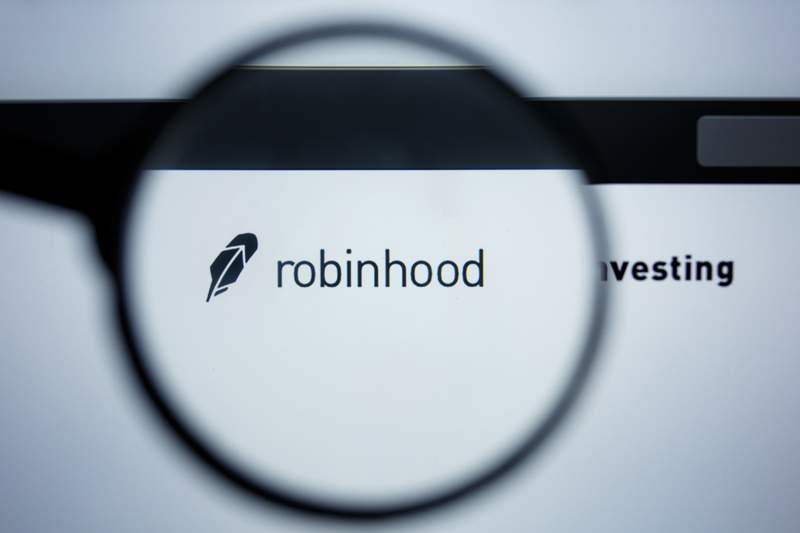How are energy investors positioned?
Introduction & Market Context
Robinhood Markets , Inc. (NASDAQ:HOOD) presented its second quarter 2025 earnings results on July 30, showcasing remarkable growth across key metrics. The company’s stock responded positively, closing up 2.69% at $103.32 in regular trading and gaining an additional 0.64% in after-hours trading to reach $103.98.
The fintech platform continues to build on its strong momentum from previous quarters, with Q2 results demonstrating substantial improvements in customer acquisition, asset growth, and profitability. This performance comes as Robinhood expands its product offerings and international presence through strategic acquisitions and organic growth initiatives.
Quarterly Performance Highlights
Robinhood reported impressive growth across all key business metrics in the second quarter of 2025. The company’s funded customer base expanded to 26.5 million, representing an increase of 2.3 million year-over-year and 750,000 sequentially.
As shown in the following chart of funded customer growth, Robinhood has maintained steady expansion of its user base:

Most notably, total platform assets nearly doubled year-over-year, reaching $279 billion – a 99% increase from Q2 2024 and a 26% sequential improvement. This substantial growth was driven by net deposits, acquired assets, and appreciation in equity and cryptocurrency valuations.
The following chart illustrates the composition and growth of Robinhood’s platform assets:
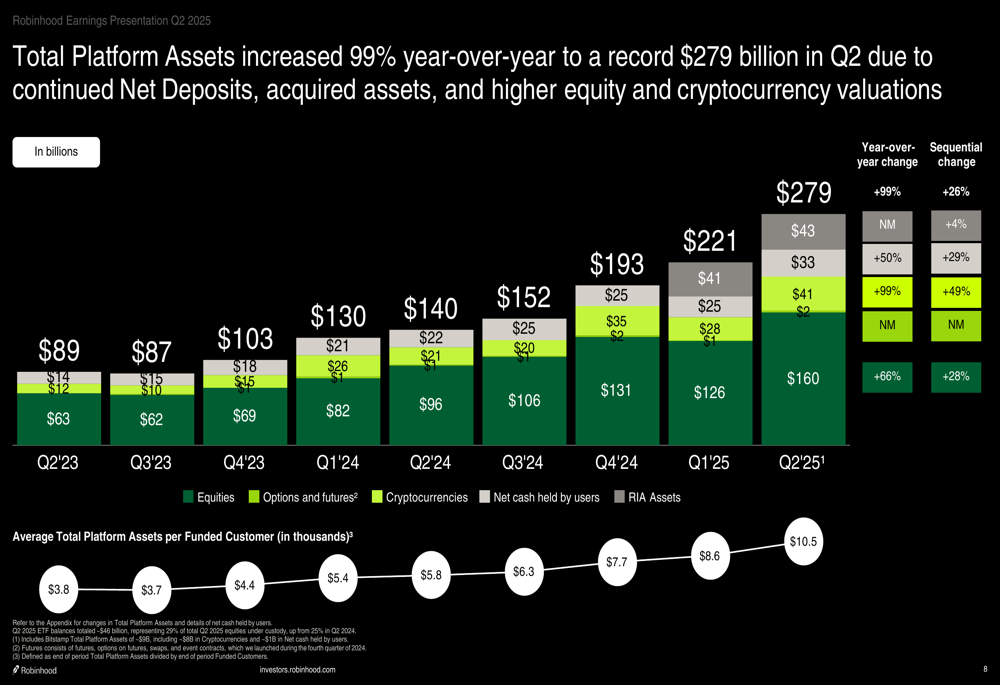
Net deposits for the quarter totaled $13.8 billion, with the last twelve months generating $58 billion in deposits at a 25% annualized growth rate. This metric is particularly important as it indicates strong customer engagement and trust in the platform.
As shown in the following chart of net deposit growth:
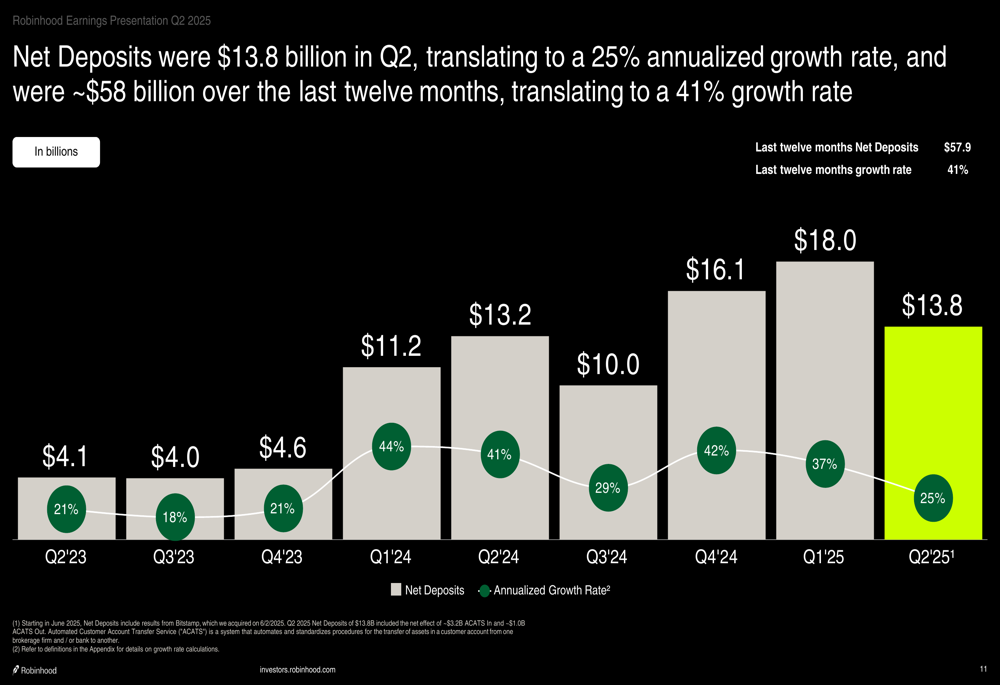
Detailed Financial Analysis
Robinhood’s financial results for Q2 2025 reflected the company’s operational success, with total net revenues reaching $989 million, up 45% year-over-year and 7% sequentially. This revenue growth was primarily driven by increases in transaction-based revenues and net interest income.
The following chart breaks down Robinhood’s revenue components:
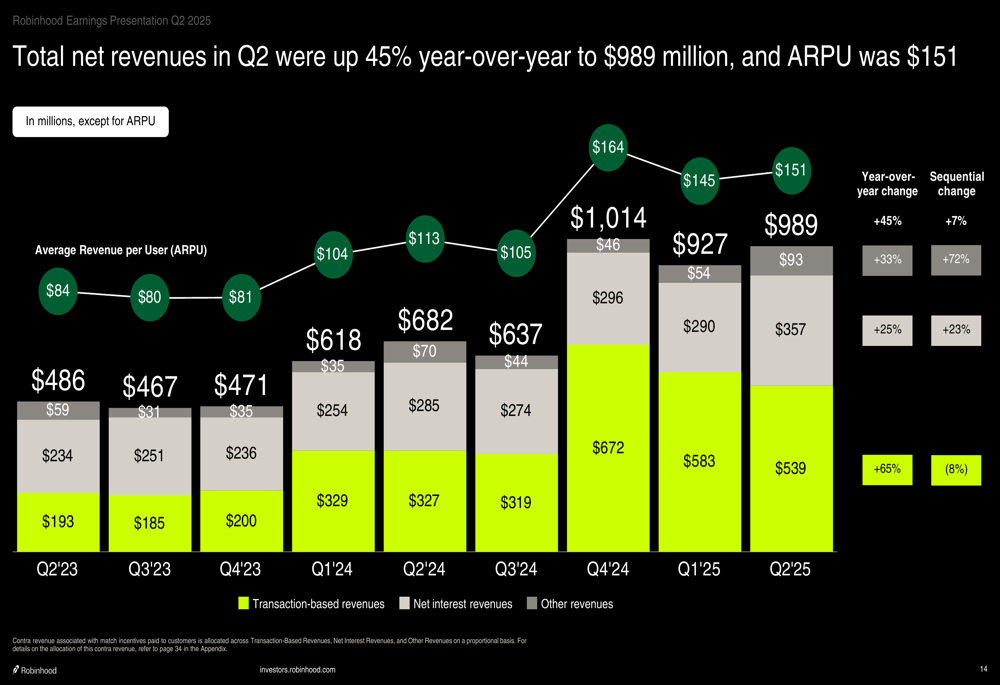
Transaction-based revenues, which include commissions from equity, options, and cryptocurrency trading, increased 65% year-over-year to $539 million. This growth was supported by record trading volumes, with equity notional volumes up 112% year-over-year to $179.1 billion and options contracts traded up 32% to 168.1 million.
The composition of transaction-based revenues is illustrated in this chart:
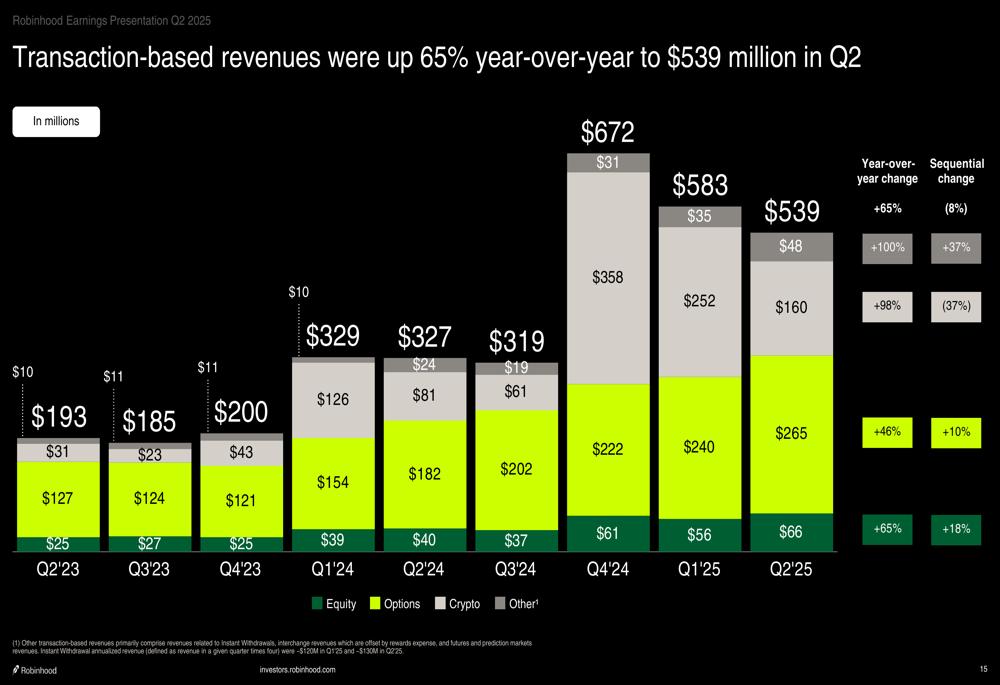
Net interest revenues also showed strong performance, increasing 25% year-over-year to a record $357 million. This growth was driven by higher interest rates on margin lending, cash sweep programs, and securities lending activities.
As shown in the following breakdown of net interest revenue:
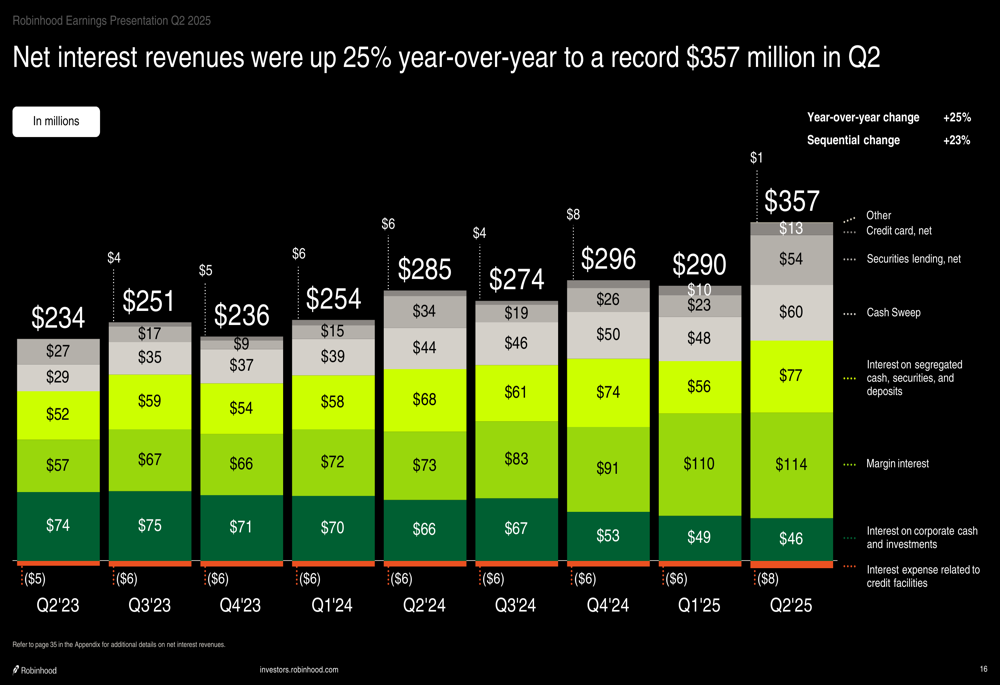
On the profitability front, Robinhood demonstrated significant improvement. Adjusted EBITDA increased 82% year-over-year to $549 million, with an impressive margin of 56%. Net income reached $386 million, up $198 million year-over-year, resulting in diluted earnings per share of $0.42 – a $0.21 increase from the same period last year.
The following chart illustrates Robinhood’s adjusted EBITDA growth and margin expansion:
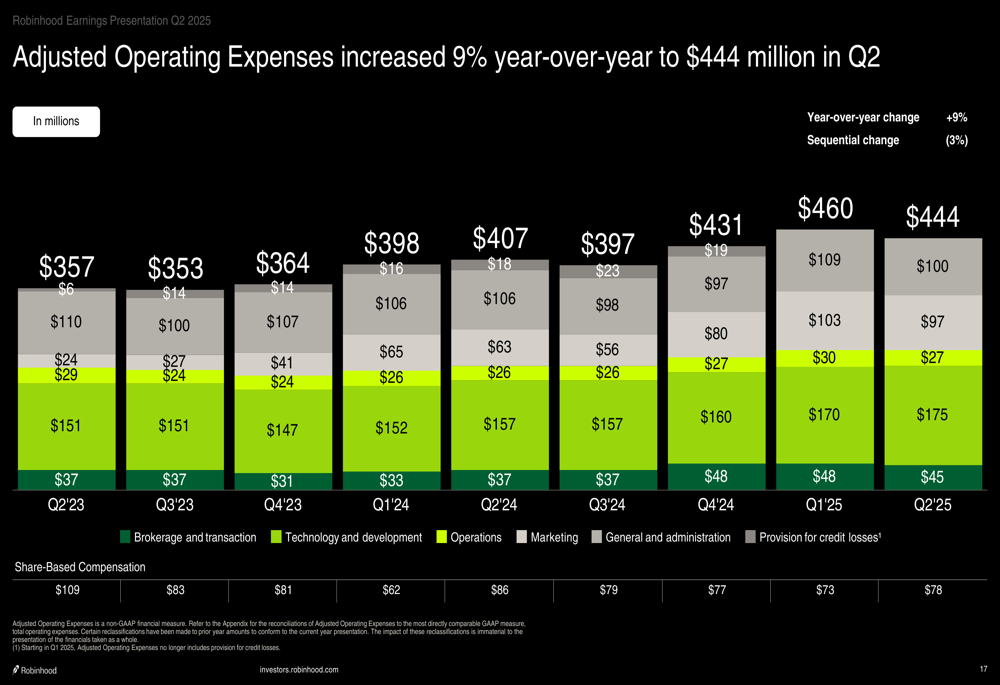
Notably, Robinhood has maintained cost discipline while driving growth. Adjusted operating expenses increased by just 9% year-over-year to $444 million, while decreasing 3% sequentially. This operational efficiency has contributed significantly to the company’s expanding profit margins.
Strategic Initiatives
Robinhood continues to execute on strategic growth initiatives across multiple fronts. The company completed the acquisition of Bitstamp during the quarter, adding approximately 520,000 funded customers and $9 billion in platform assets. Additionally, Robinhood announced the acquisition of WonderFi and expanded its presence to 30 countries across the European Union and European Economic Area.
The Robinhood Gold subscription program has emerged as a significant growth driver, with subscribers increasing 76% year-over-year to 3.48 million, representing 13.1% of funded customers. Gold subscribers demonstrate substantially higher engagement and value, with approximately 5 times the assets under custody compared to average customers.
As shown in the following chart highlighting the value proposition of Robinhood Gold:
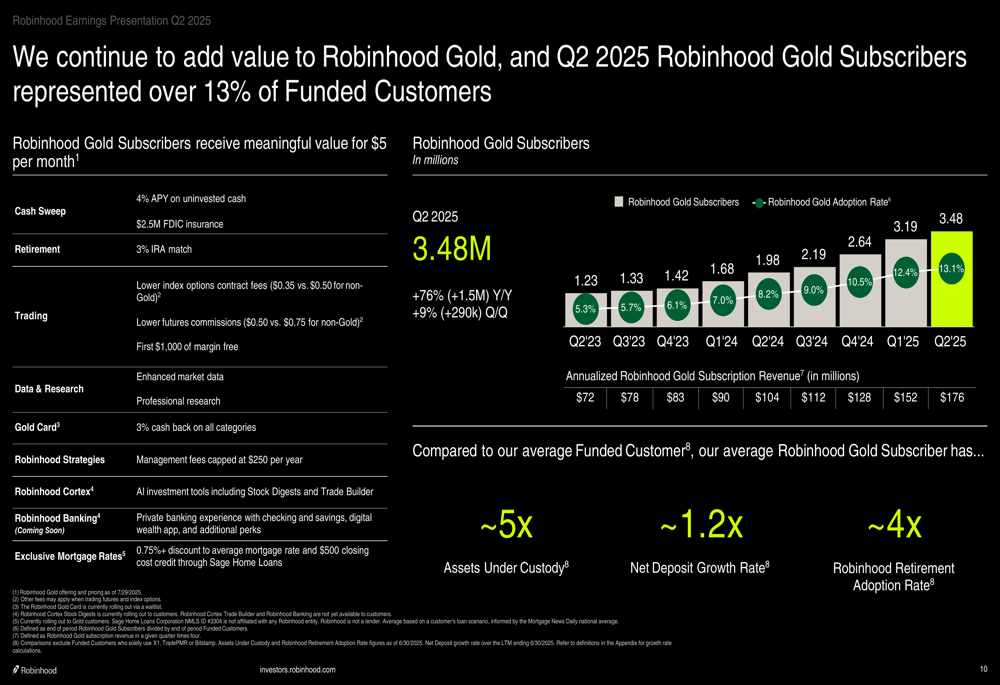
Robinhood’s retirement accounts also showed impressive growth, with assets under custody reaching $19 billion in Q2 2025, up from just $0.8 billion in Q2 2023. This rapid expansion demonstrates the company’s success in diversifying its product offerings beyond trading.
The company’s capital return program remains active, with $124 million returned to shareholders through the repurchase of approximately 3 million shares during Q2. Over the past twelve months, Robinhood has returned approximately $700 million by repurchasing 21 million shares, with approximately $800 million remaining in its authorized repurchase program.
Forward-Looking Statements
Looking ahead, Robinhood updated its 2025 outlook for adjusted operating expenses and share-based compensation to account for recent acquisitions. The company now expects adjusted operating expenses to range between $2.15 billion and $2.25 billion for the full year, incorporating additional costs from the Bitstamp and TradePMR acquisitions.
As illustrated in the following chart of the updated expense outlook:
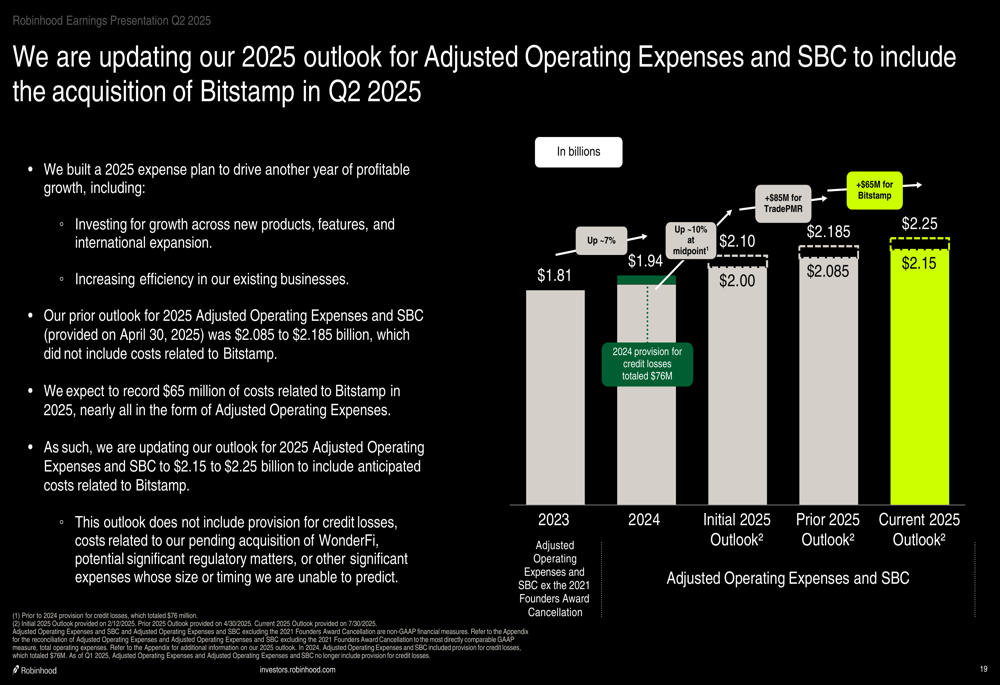
Robinhood’s 2025 roadmap focuses on three strategic pillars: enhancing offerings for active traders, increasing wallet share among next-generation investors, and building a global financial ecosystem. Key initiatives include Robinhood Legend enhancements, Robinhood Gold Card expansion, and additional cryptocurrency capabilities.
The company expects to continue its international expansion while maintaining operational efficiency. Management anticipates diluted share count to decrease by approximately 1% in 2025, reflecting ongoing share repurchases and disciplined management of share-based compensation.
With a strong balance sheet showing over $4 billion in corporate cash, investments, and stablecoin, Robinhood is well-positioned to pursue its growth strategy while continuing to return capital to shareholders. The company’s "Rule of 40" metric, which combines revenue growth and adjusted EBITDA margin, reached an impressive 112% for the last twelve months, demonstrating the power of its business model and operational execution.
Full presentation:
This article was generated with the support of AI and reviewed by an editor. For more information see our T&C.
